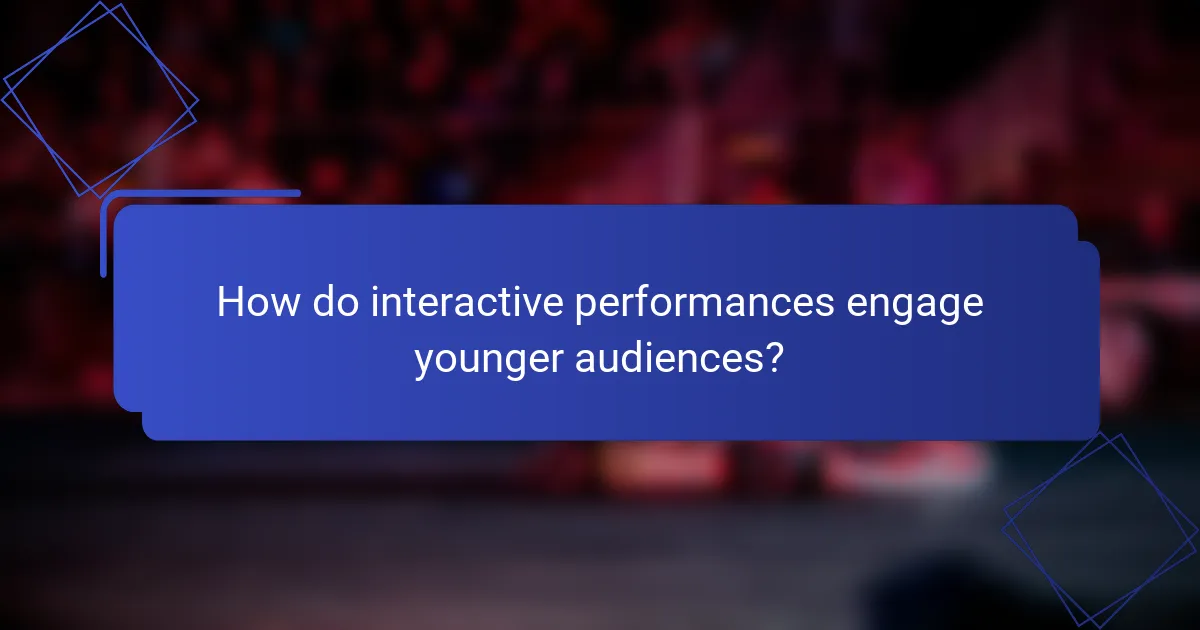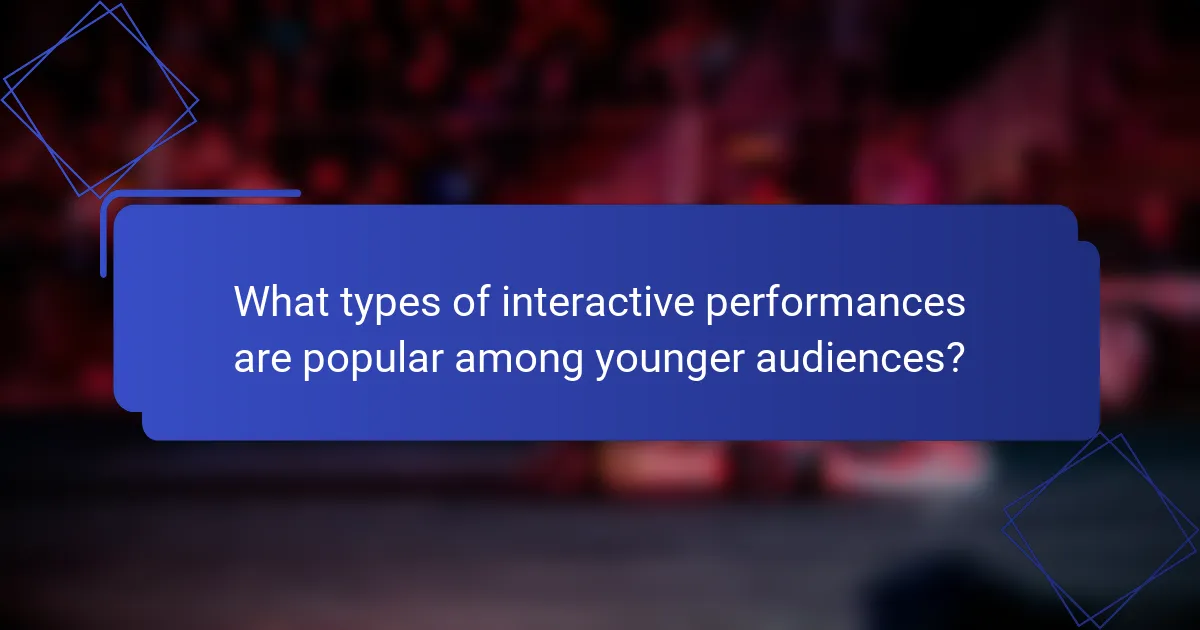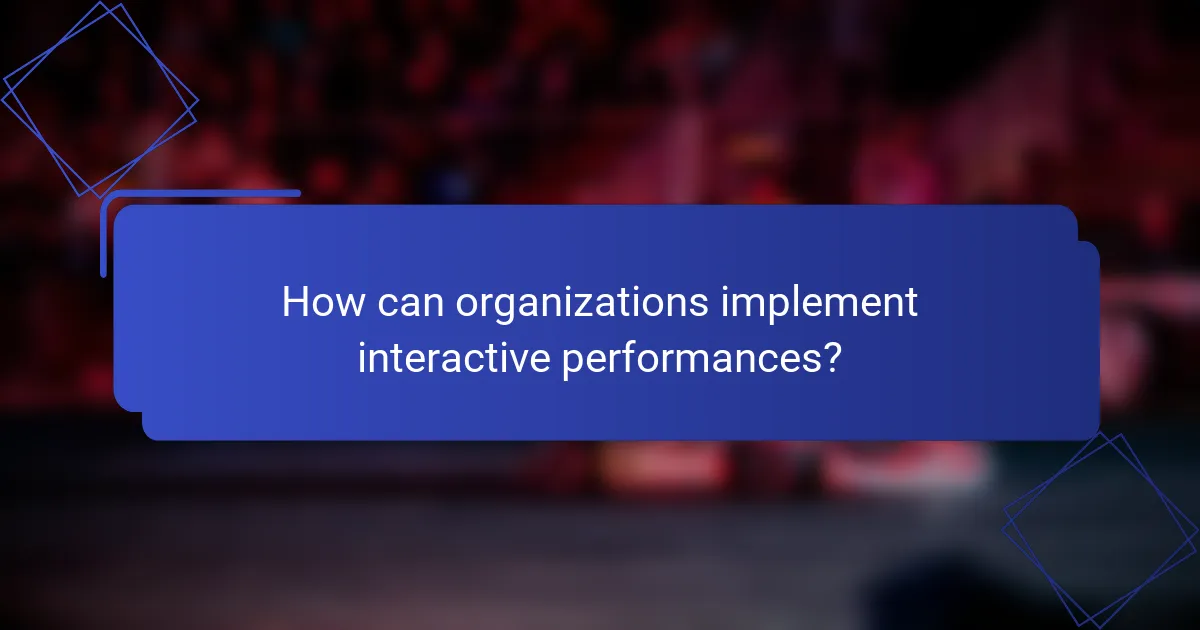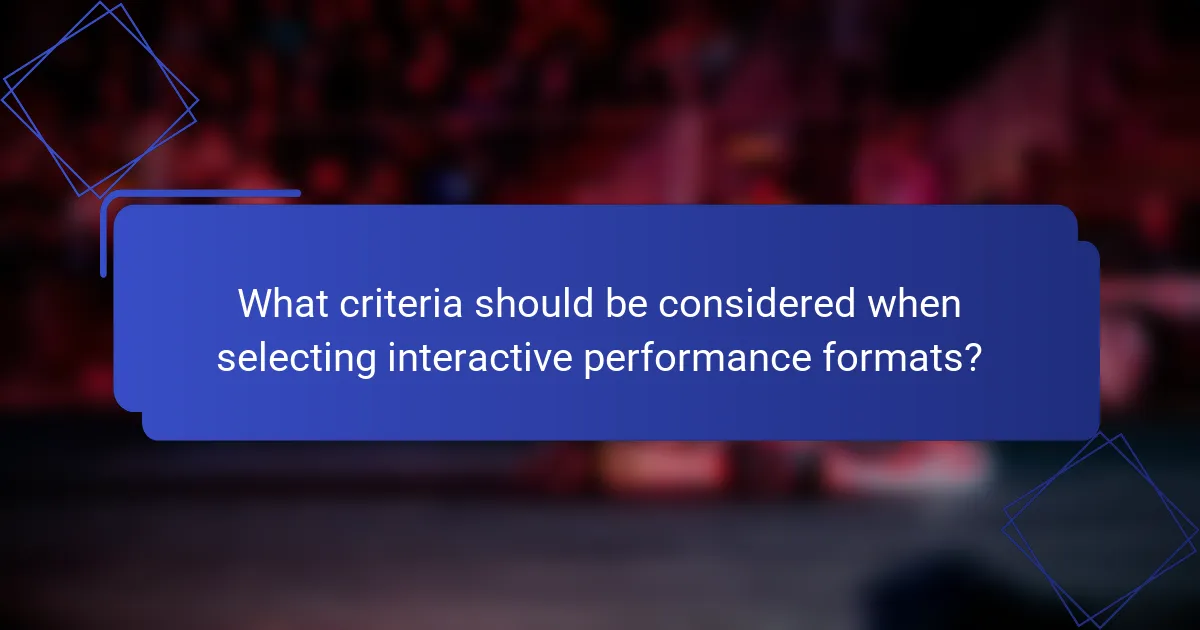Interactive performances are an effective way to engage younger audiences by encouraging active participation and fostering a sense of connection to the experience. By transforming passive viewers into engaged participants, these performances not only enhance enjoyment but also improve retention of information and social skills. Formats such as immersive theater and virtual reality provide unique opportunities for youth to connect with the content and each other in meaningful ways.

How do interactive performances engage younger audiences?
Interactive performances engage younger audiences by inviting them to actively participate in the experience, fostering a sense of ownership and connection. This approach transforms passive viewers into engaged participants, enhancing their overall enjoyment and retention of the content.
Increased participation
Interactive performances encourage younger audiences to take part in the action, whether through direct involvement or by influencing the storyline. This can be achieved through audience voting, role-playing, or hands-on activities that require their input.
For instance, theater productions that allow the audience to choose the next scene or characters can significantly boost engagement. This level of participation not only keeps attention but also makes the experience feel more relevant and personal.
Enhanced emotional connection
By involving younger audiences in the narrative, interactive performances create stronger emotional ties to the content. When participants feel they have a stake in the outcome, their investment in the story deepens.
Techniques such as personalized interactions with performers or immersive environments can evoke empathy and emotional responses. For example, a performance that addresses social issues relevant to young people can resonate more deeply when they are part of the dialogue.
Memorable experiences
Interactive performances often lead to unforgettable experiences that stand out in the minds of younger audiences. The combination of active participation and emotional engagement creates lasting memories that traditional performances may not achieve.
To maximize memorability, consider incorporating unique elements like surprise interactions or unexpected twists that require audience involvement. These features can transform a standard performance into an event that participants eagerly share with peers, amplifying its impact.

What are the benefits of interactive performances for youth?
Interactive performances offer numerous benefits for engaging younger audiences, including enhanced social skills, increased creativity, and improved retention of information. These performances create immersive environments where youth can actively participate, fostering a deeper connection to the material.
Improved social skills
Participating in interactive performances allows youth to develop essential social skills through collaboration and communication. Engaging with peers in a creative setting encourages teamwork, active listening, and empathy, which are vital for personal and professional relationships.
For example, group activities during performances can help children learn to express their thoughts and feelings while respecting others’ viewpoints. This practice can lead to more confident interactions in various social situations.
Boosted creativity
Interactive performances stimulate creativity by allowing youth to explore their imagination and express themselves in unique ways. When participants are encouraged to contribute ideas and make choices, they develop critical thinking skills and innovative problem-solving abilities.
Activities such as improvisation or role-playing can inspire young audiences to think outside the box, leading to original concepts and artistic expression. This creative engagement can be particularly beneficial in educational settings, where it enhances learning experiences.
Greater retention of information
Engaging in interactive performances can significantly improve information retention among youth. When participants actively engage with content, they are more likely to remember key concepts and details compared to passive learning methods.
Research suggests that experiential learning, such as participating in performances, can enhance memory retention by up to 70%. This method encourages youth to connect emotionally with the material, making it more memorable and impactful.

What types of interactive performances are popular among younger audiences?
Younger audiences are increasingly drawn to interactive performances that allow them to engage actively rather than passively observe. Popular formats include immersive theater, interactive workshops, and virtual reality experiences, each offering unique ways for participants to connect with the content and each other.
Immersive theater
Immersive theater breaks the traditional boundaries of stage and audience, allowing participants to explore the performance space and interact with actors. This format often involves storytelling that unfolds in real-time, encouraging audience members to influence the narrative through their choices.
Examples of immersive theater include productions where the audience moves through different rooms, each presenting a part of the story. This engagement can enhance emotional investment, making the experience memorable and impactful.
Interactive workshops
Interactive workshops provide hands-on experiences that allow younger audiences to learn and create in a collaborative environment. These sessions often focus on skills such as acting, writing, or even technical aspects of performance, fostering creativity and teamwork.
Workshops can vary in duration from a couple of hours to several days and often culminate in a performance or showcase. They are particularly effective in educational settings, where students can apply what they’ve learned in a supportive atmosphere.
Virtual reality experiences
Virtual reality (VR) experiences immerse participants in a digital environment, allowing them to interact with 3D worlds and characters. This technology can transport users to fantastical settings or historical events, enhancing their engagement through sensory experiences.
VR performances can range from short experiences of 10-30 minutes to longer narratives that unfold over an hour. As VR technology becomes more accessible, it offers exciting opportunities for younger audiences to experience storytelling in innovative ways.

How can organizations implement interactive performances?
Organizations can implement interactive performances by focusing on collaboration, technology, and audience engagement. These strategies help create immersive experiences that resonate with younger audiences and encourage participation.
Collaborate with local artists
Partnering with local artists can enhance the authenticity and appeal of interactive performances. Artists bring unique perspectives and skills that can enrich the creative process, making the experience more relatable for younger audiences.
Consider hosting workshops or brainstorming sessions with local talent to generate ideas and foster community involvement. This collaboration not only supports local creatives but also helps build a loyal audience base.
Utilize technology effectively
Incorporating technology can significantly elevate interactive performances. Tools like augmented reality (AR), mobile apps, and social media platforms can facilitate audience participation and create a more engaging experience.
For example, using an app to allow real-time voting on performance elements can make the audience feel more involved. Ensure that the technology is user-friendly and accessible to avoid alienating participants who may not be tech-savvy.
Incorporate feedback mechanisms
Implementing feedback mechanisms is crucial for refining interactive performances. Collecting audience input through surveys, comment cards, or digital platforms can provide valuable insights into what resonates with younger viewers.
Consider offering incentives, such as discounts on future events or exclusive content, to encourage feedback. Regularly reviewing and acting on this feedback can help organizations adapt and improve their offerings over time.

What criteria should be considered when selecting interactive performance formats?
When selecting interactive performance formats, consider factors such as the target audience’s preferences, budget constraints, and the overall goals of the performance. These criteria will help ensure that the chosen format effectively engages younger audiences and meets logistical requirements.
Target audience preferences
Understanding the preferences of younger audiences is crucial when selecting interactive performance formats. This demographic often favors immersive experiences that allow for participation and engagement, such as workshops, live polls, or gamified elements. Conducting surveys or focus groups can provide insights into specific interests and desired formats.
Additionally, consider the technological familiarity of the audience. Younger audiences are typically more comfortable with digital interactions, so incorporating apps or social media elements can enhance their experience. Tailoring the performance to align with their interests and habits will increase engagement.
Budget constraints
Budget constraints play a significant role in determining the feasibility of various interactive performance formats. Costs can vary widely depending on the technology used, the scale of the performance, and the resources required for execution. Establishing a clear budget early on will help prioritize which elements are essential and which can be adjusted or eliminated.
When working with limited funds, consider low-cost alternatives such as utilizing existing venues or community spaces, and leveraging local talent for performances. Additionally, exploring sponsorship opportunities or partnerships can provide financial support while enhancing the overall experience without compromising quality.



